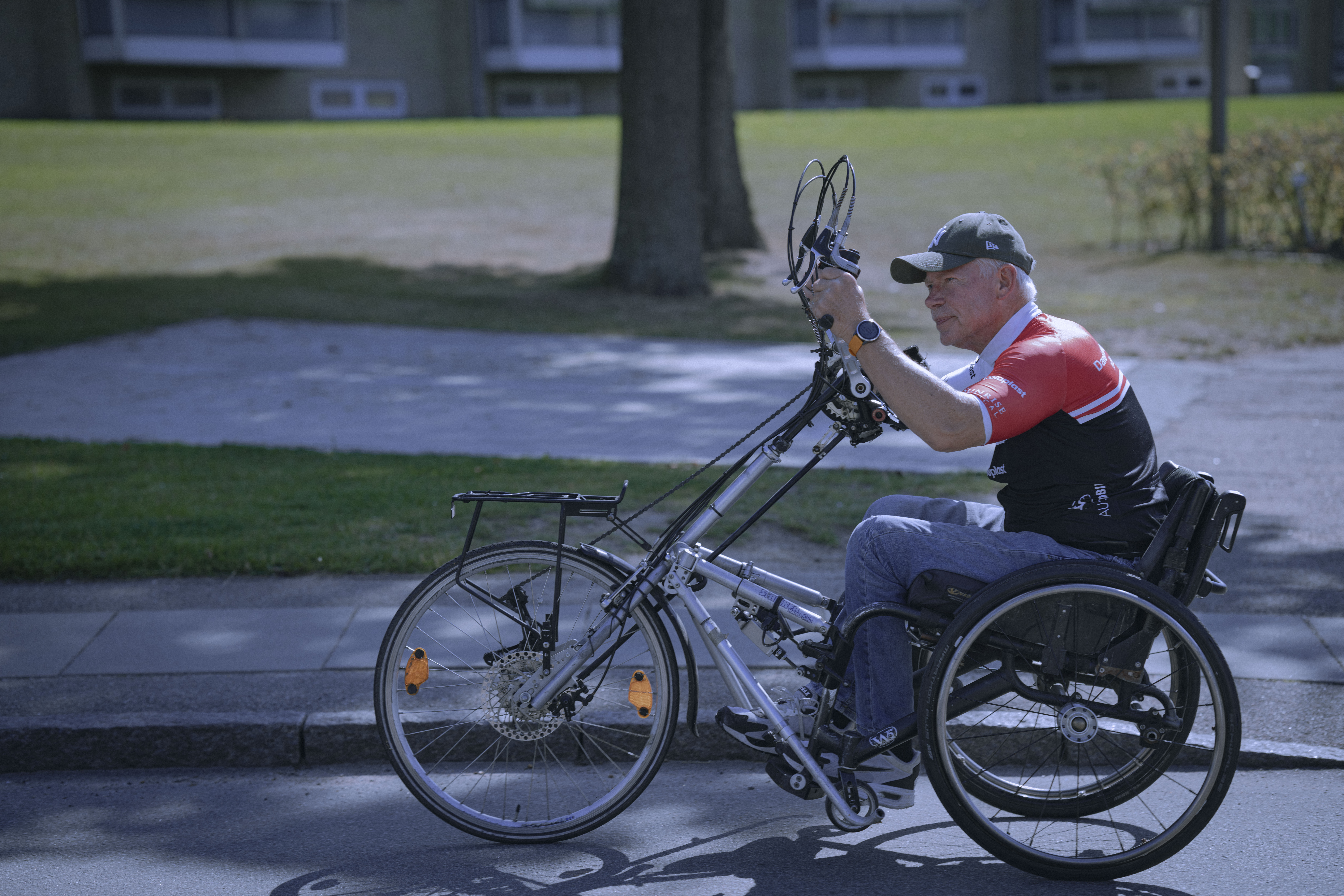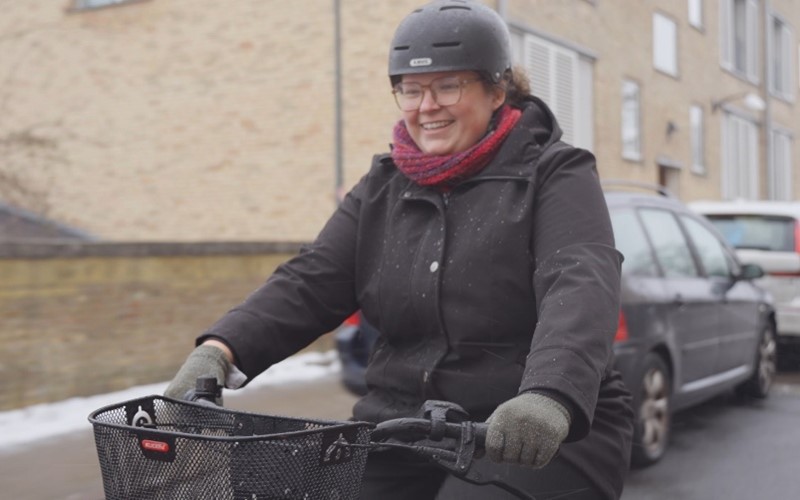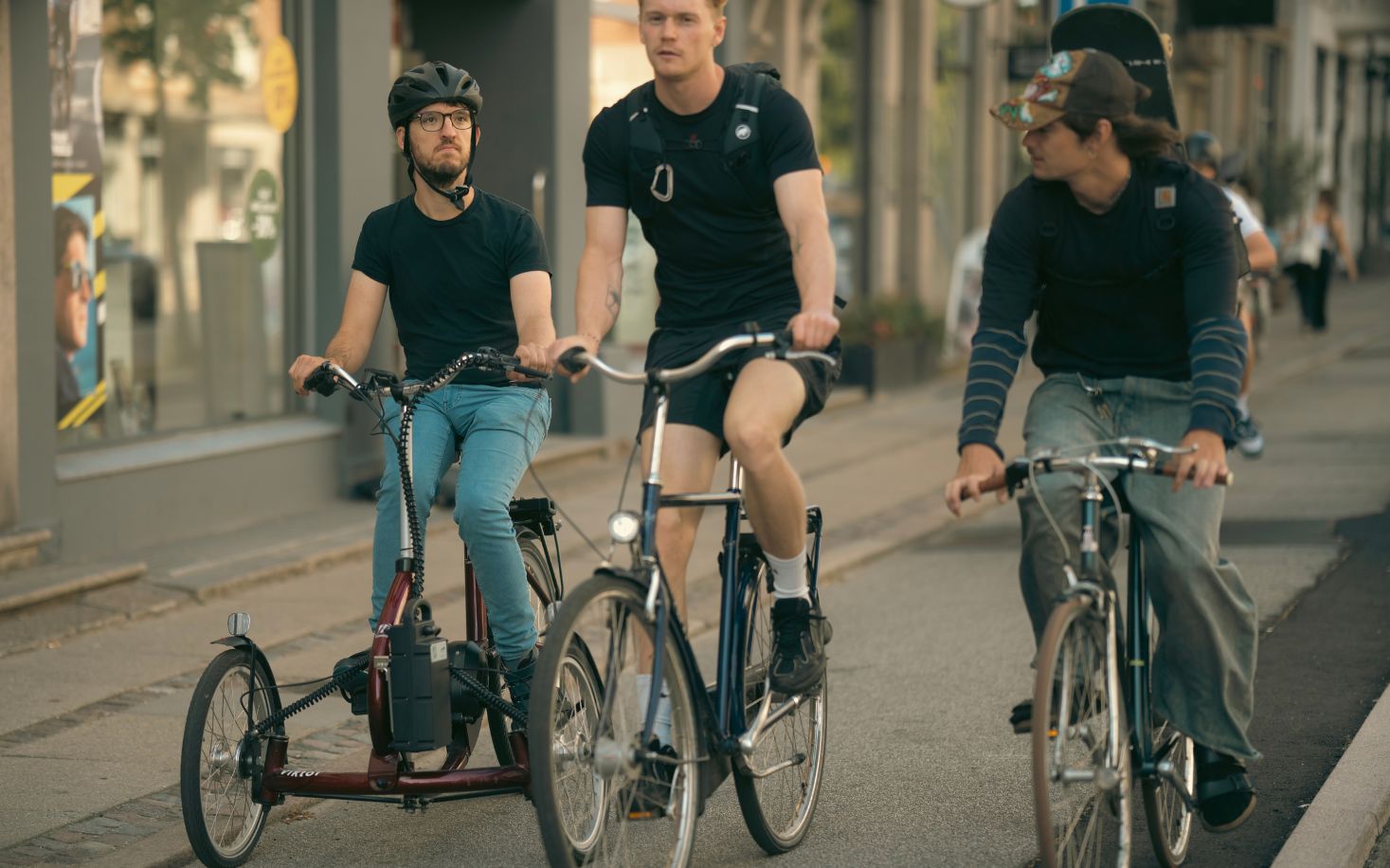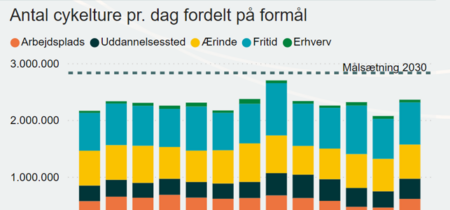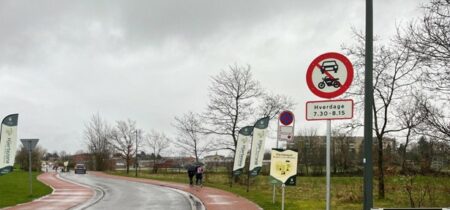Promoting cycling among people with disabilities
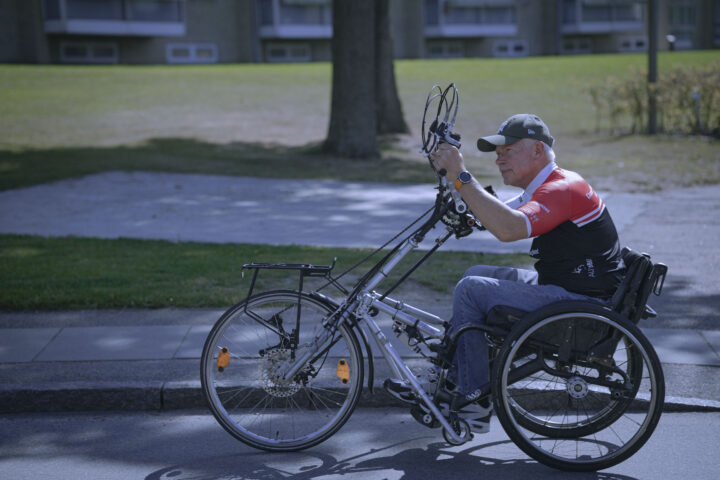 Cycling gives people with disabilities better mobility, health, mental well-being and social participation. Photo: The Danish Cyclists' Federation/Marie Hald
Cycling gives people with disabilities better mobility, health, mental well-being and social participation. Photo: The Danish Cyclists' Federation/Marie Hald Cycling improves mobility, health, mental well-being and social participation for people with disabilities. Unfortunately, this group of citizens often experiences challenges that prevent them from cycling. Therefore, the Danish Cyclists’ Federation and the Danish Knowledge Centre on Disability have made six recommendations for measures that can strengthen cycling among people with disabilities.
By Mai-Britt Aagaard Kristensen, Project Manager at the Danish Cyclists’ Federation
Cycling must be for everyone – including people with disabilities
In Denmark, cycling is widespread among the broad population, including children, ministers and even royalty. But unfortunately, this does not apply to the same extent for people with disabilities. This is shown by a new study from the Danish Cyclists’ Federation and the Danish Knowledge Center on Disability: “Cycling for All, 2024”.
The study reveals great potential for increasing cycling among people with disabilities. Increased cycling can lead to significant health and well-being benefits for this group of citizens. Based on the study, six recommendations have been drawn up to help professionals and decision-makers across sectors to promote cycling for people with disabilities.
“It gives me so much joy in my day-to-day life that I can be self-reliant, mobile and recharge in nature” – Bettina Søndergaard, 42 years old, autism, anxiety, ADD and fibromyalgia
People with disabilities want to cycle
Some might ask: “Can and will people with disabilities even ride a bike?”. The answer is yes. People with disabilities are a large and diverse group, which covers both physical disabilities (e.g. muscular dystrophy, spinal cord injury, cerebral palsy), mental disabilities (e.g. anxiety, bipolar disorder), cognitive disabilities (e.g. ADHD, autism, down syndrome) and sensory disabilities (e.g. visual and hearing impairment).
According to Danish Center for Social Science Research, 31% of the Danish population aged 16-64 years has a self-reported mental or physical disability (Amilon et al., 2021). Among them is a large group who, with targeted efforts, can gain access to and benefit from cycling.
The study shows, among other things, that:
- 67% of adults with disabilities want to cycle more.
- 55% of adults with disabilities cycle in order to participate in social interactions on an equal footing with friends and family.
- 64.3% of adults with disabilities see cycling as a way to independence.
- 77.1% of parents of children with disabilities want their children to cycle more.
- 63% of parents of children with disabilities say their children cycle to participate in social interactions on an equal footing with others.
- 85.3% of parents of children with disabilities see cycling as a way to increase independence for their children.
Cycling is for everyone: For Jan Jørgensen, who is a wheelchair user and handcyclist, and Anton Stockmarr, who has cerebral palsy and rides an electric tricycle, cycling provides a better quality of life. (Video in Danish)
The bicycle enhances freedom, health and social participation
It is well known that cycling brings a wide range of benefits to the individual. This is especially true for people with disabilities.
For a wheelchair user, a handcycle can provide much-needed exercise in everyday life. For the young person with cerebral palsy, an electric tricycle can compensate for a lack of strength in the legs and thus provide a longer radius of action and offer access to an activity that their peers do without hesitation. For a person with anxiety, the bicycle can be a calming way to commute rather than having to stand in a packed bus, which requires a lot of mental resources before the working day begins. For the child with autism, the school’s focus on cycling can provide self-confidence, freedom and higher self-esteem. For a child with cerebral palsy, learning to ride a bike can help make the child more independent from their parents. What they all have in common is that the bicycle offers an important source of quality of life.
- For a person with anxiety, the bicycle can be a calming mode of commuting rather than having to stand up in a packed bus, which requires a lot of mental resources even before the work day begins. Photo: Cyklistforbundet
- For young persons with cerebral palsy, a tricycle can compensate for the lack of strength in the legs and provide access to activities that peers do with the utmost confidence. Photo: Cyklistforbundet/Marie Hald
Barriers to cycling among people with disabilities
Although many people with disabilities want to ride a bike, there are still a number of barriers that stand in the way, such as:
- Unsafe cycling infrastructure
- Lack of consideration from fellow road users
- Lack of knowledge about special bicycles customized for disabled people
- Complicated application procedures for financial support for disability-friendly cycles
In terms of infrastructure, there is a particular need for cycle routes to be safe, level-free and free of obstacles such as stairs and poor lighting. In addition, people with disabilities experience a number of specific challenges such as:
- The slope of the cycle path, which can make it difficult to cycle on a tricycle.
- Too tight barriers or bollards that prevent passage with, for example, a tandem bike.
- Missing or too steep ramps at tunnels and bridges.
- Complicated detours during roadworks.
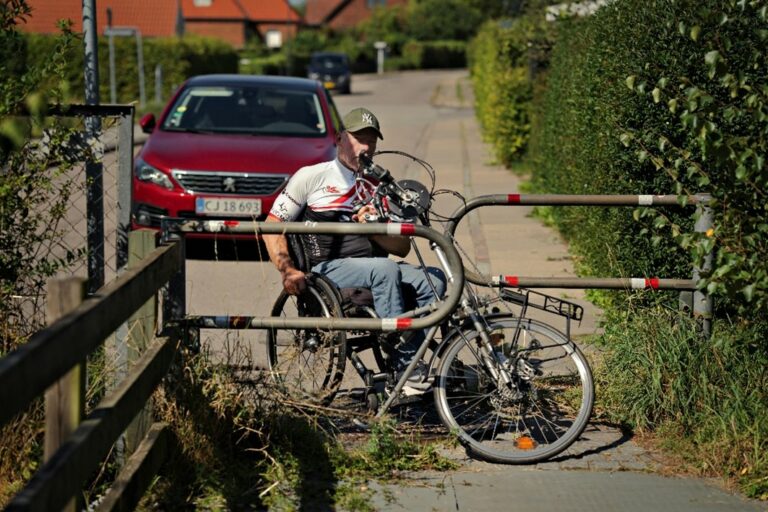
- One of the barriers to cycling for people with disabilities is inaccessible cycling infrastructure such as too narrow barriers that make it difficult or impossible to pass with e.g., a tricycle. Photo: Cyklistforbundet/Marie Hald
In general, the Danish cycling culture is often portrayed in words and pictures in the form of a cyclist on a two-wheeled bicycle or perhaps a family with children in a cargo bike. This imagery supports an unconscious notion that people with disabilities do not cycle.
There is a need for recognition among cycling professionals that, on the one hand, people with disabilities also cycle or want to cycle, and on the other hand that this group also has some special needs and challenges in relation to cycling, which should be taken into account in the planning and design of the cycling infrastructure.
How can we promote cycling for people with disabilities?
The Danish Cyclists’ Federation and the Danish Knowledge Centre on Disability have made six recommendations that can contribute to breaking down the barriers to cycling among persons with disabilities. In summary, the recommendations include:
- Ensure safe and accessible cycling infrastructure
- Reinforce good cyclist behaviour
- Make sure your measures to promote cycling embrace different needs
- Create more possibilities to (re)learn to ride a bike
- Develop and promote grants, guidance and rental schemes for special bicycles
- Understand and use cycling as an activity in social and health care
Read the full recommendations on cyklistforbundet.dk/cyklingforalle (in Danish).
The recommendations are aimed at professionals across the traffic, social and health sectors, including:
- Traffic planners
- Physiotherapists and occupational therapists
- Case workers and social educators
- Professionals in cycling and social services
Here it is worth noting the wording across sectors as accessible infrastructure and inclusive cycling measures do not do it alone. It is also necessary that professionals in the health and social sectors become aware of what the bicycle can mean for people with disabilities, and are better equipped to guide them towards different opportunities to cycle more. If we are to raise the cycling potential among people with disabilities and create a more inclusive cycling culture, we need to think and collaborate across sectors.
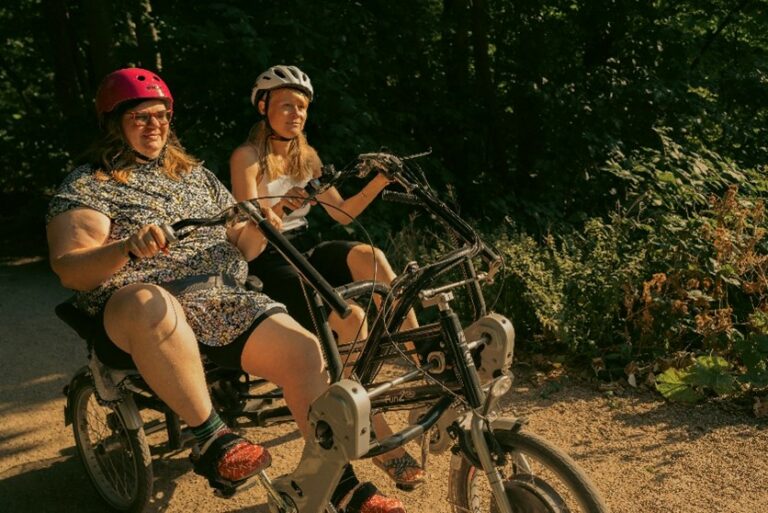
- To reach the full potential for cycling among people with disabilities and create a more inclusive cycling culture, we need to think and collaborate across sectors. Photo: Cyklistforbundet/Marie Hald
Online resources at cyklistforbundet.dk/cyklingforalle (in Danish only)
- The study report ‘Cycling for all, 2024’
- 6 recommendations for promotion measures
- 9 portraits of cyclists with disabilities
- Overview of special needs bikes
- Danish and international best practice
The study 'Cycling for all, 2024'
The study ‘Cycling for All, 2024′ is part of the Danish Cyclists’ Federation and the Danish Knowledge Center on Disability’s project of the same name, which is supported by the Danish State’s cycling fund 2022. The study consists of an overview of existing knowledge and best practice from Denmark and abroad and a summary of two questionnaire surveys among adults with disabilities (421 responses) and parents of children with disabilities (362 responses), as well as three focus group interviews with the aforementioned two target groups and a group of professionals.

